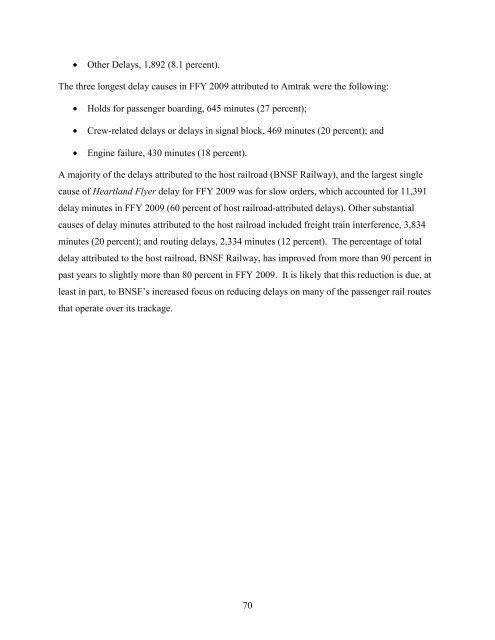Measuring the Benefits of Intercity Passenger Rail: A Study
Measuring the Benefits of Intercity Passenger Rail: A Study
Measuring the Benefits of Intercity Passenger Rail: A Study
You also want an ePaper? Increase the reach of your titles
YUMPU automatically turns print PDFs into web optimized ePapers that Google loves.
• O<strong>the</strong>r Delays, 1,892 (8.1 percent).<br />
The three longest delay causes in FFY 2009 attributed to Amtrak were <strong>the</strong> following:<br />
• Holds for passenger boarding, 645 minutes (27 percent);<br />
• Crew-related delays or delays in signal block, 469 minutes (20 percent); and<br />
• Engine failure, 430 minutes (18 percent).<br />
A majority <strong>of</strong> <strong>the</strong> delays attributed to <strong>the</strong> host railroad (BNSF <strong>Rail</strong>way), and <strong>the</strong> largest single<br />
cause <strong>of</strong> Heartland Flyer delay for FFY 2009 was for slow orders, which accounted for 11,391<br />
delay minutes in FFY 2009 (60 percent <strong>of</strong> host railroad-attributed delays). O<strong>the</strong>r substantial<br />
causes <strong>of</strong> delay minutes attributed to <strong>the</strong> host railroad included freight train interference, 3,834<br />
minutes (20 percent); and routing delays, 2,334 minutes (12 percent). The percentage <strong>of</strong> total<br />
delay attributed to <strong>the</strong> host railroad, BNSF <strong>Rail</strong>way, has improved from more than 90 percent in<br />
past years to slightly more than 80 percent in FFY 2009. It is likely that this reduction is due, at<br />
least in part, to BNSF’s increased focus on reducing delays on many <strong>of</strong> <strong>the</strong> passenger rail routes<br />
that operate over its trackage.<br />
70
















